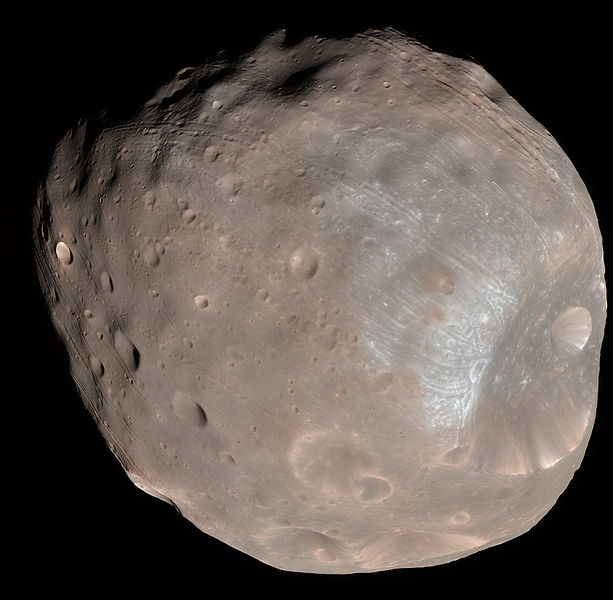
Martian moon Phobos.Credit: <a href="http://commons.wikimedia.org/wiki/File:Phobos_colour_2008.jpg">NASA/JPL-Caltech/University of Arizona</a>.
Russia’s Phobos-Grunt space probe has been stalled in low orbit since its 8 November launch and is now in danger of falling back to Earth, possibly by January. The spacecraft is supposed to travel to Mars’ moon Phobos to collect soil and return home. But Phobos-Grunt never fired its engines from orbit. And it hasn’t answered calls from ground controllers.
This is not a good thing in light of Phobos-Grunt’s hydrazine rocket fuel—a highly toxic and unstable inorganic compound dangerous to life in even short or small exposures. Phobos means “fear” in Greek. According to the EPA:
Symptoms of acute (short-term) exposure to high levels of hydrazine may include irritation of the eyes, nose, and throat, dizziness, headache, nausea, pulmonary edema, seizures, and coma in humans. Acute exposure can also damage the liver, kidneys, and central nervous system in humans. The liquid is corrosive and may produce dermatitis from skin contact in humans and animals. Effects to the lungs, liver, spleen, and thyroid have been reported in animals chronically (long-term) exposed to hydrazine via inhalation. Increased incidences of lung, nasal cavity, and liver tumors have been observed in rodents exposed to hydrazine. EPA has classified hydrazine as a Group B2, probable human carcinogen.
New Scientist reports that NASA destroyed one of its own falling satellites in 2008 to minimize the possibility of hydrazine contamination on Earth—though the fact that it was also a spy satellite might have had something to do with it. Plus it offered the opportunity to fire an SM-3 ballistic missile from ship to orbit in genuine Star Wars style. From New Scientist:
Under international law, Russia would be liable for any damage caused by hydrazine from Phobos-Grunt reaching the ground, says Michael Listner, an attorney and space policy analyst based in Portsmouth, New Hampshire. “Let’s hope this thing falls in the ocean or an unpopulated area,” he says.
Like there’s nothing in the ocean that matters. I wrote earlier in the Radioactive Ocean about all the nuclear junk relegated to the bottom of the sea—forgotten but not gone. Let’s hope Phobos-Grunt starts talking.










